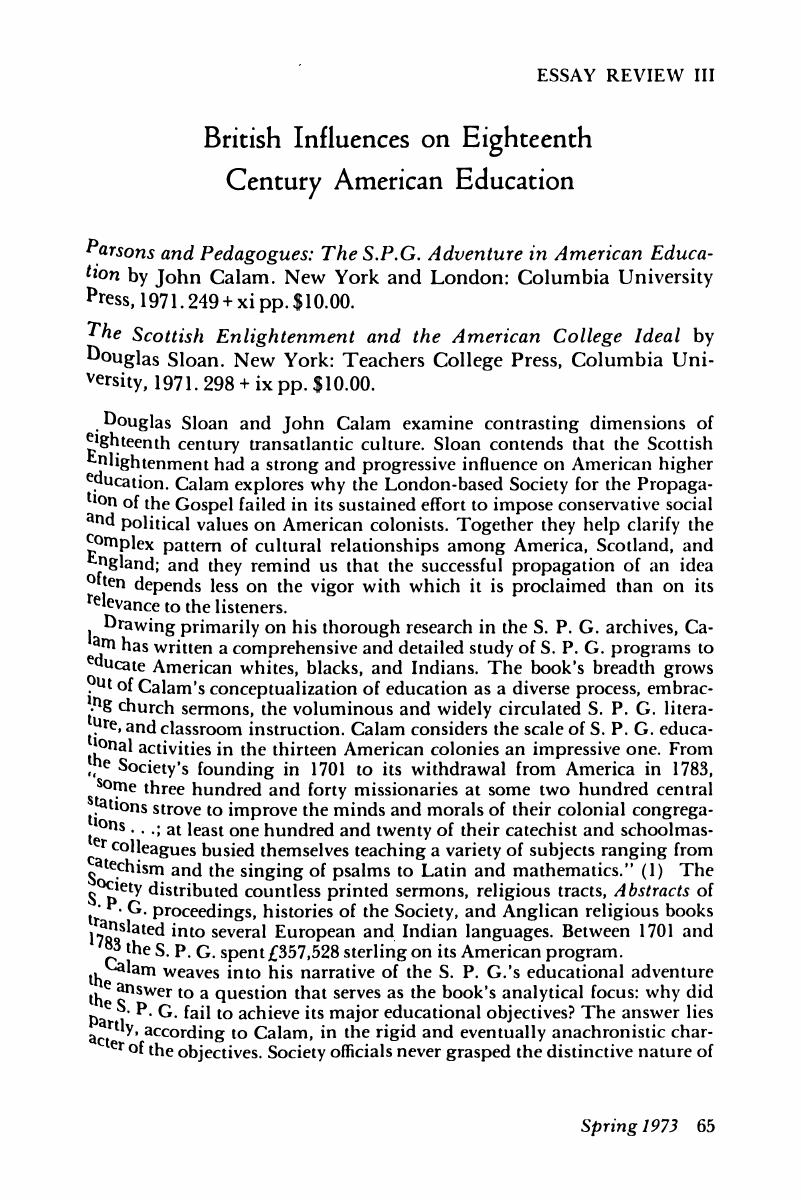No CrossRef data available.
Article contents
British Influences on Eighteenth Century American Education - Parsons and Pedagogues: The S.P.G. Adventure in American Education by John Calam. New York and London: Columbia University Press, 1971. 249 + xi pp. $10.00. - The Scottish Enlightenment and the American College Ideal by Douglas Sloan. New York: Teachers College Press, Columbia University, 1971. 298 + ix pp. $10.00.
Published online by Cambridge University Press: 02 June 2017
Abstract

- Type
- Essay Review III
- Information
- Copyright
- Copyright © 1973 by New York University
References
Notes
1 Calam, John, Parsons and Pedagogues: The S. P. G. Adventure in American Education (New York and London, 1971), p. 199.Google Scholar
2 Ibid., pp. 66, 70, 215.Google Scholar
3 Bridenbaugh, Carl, Mitre and Sceptre: Transatlantic Faiths, Ideas, Personalities, and Politics, 1689–1775 (New York, 1962), pp. 26, 31, 54, 57, 74, 110, 121.Google Scholar
4 Calam, , Parsons and Pedagogues, p. 60. Several Ph.D. dissertations written in the 1960's suggest how such factors as ideological rifts, geographic localism (with clerical horizons often extending no farther than parish boundaries), and lay-clerical conflict contributed to a fragmentation of the S. P. G.'s efforts. See especially Goodwin, Gerald, “The Anglican Middle Way in Early Eighteenth-Century America: Anglican Religious Thought in the American Colonies, 1702–1750” (Univ. of Wisc., 1965); Mills, Frederick V., “Anglican Resistance to an American Episcopate, 1761–1789” (Univ. of Penn., 1967); Painter, Borden, “The Anglican Vestry in Colonial America” (Yale Univ., 1965); and Steiner, Bruce E., “Samuel Seabury and the Forging of the High Church Tradition: A Study in the Evolution of New England Churchmanship, 1722–1796” (Univ. of Va., 1962).Google Scholar
5 Calam, , Parsons and Pedagogues, p. 199; Turner Main, Jackson, The Social Structure of Revolutionary America (Princeton, N. J., 1965), p. 102.Google Scholar
6 [Philip Bearcroft] to Samuel Johnson, Oct. 4, 1749, copy, ♯205, S. P. G. Letters, series B, vol. XVII, transcript, Library of Congress; S. P. G. Journals, Meetings of April 7, April 14, 1749, and March 16, 1749/50, vol. XI, photostats, Library of Congress.Google Scholar
7 Calam, , Parsons and Pedagogues, p. 108.Google Scholar
8 Calam, John, “Parsons and Pedagogues: The S. P. G. Adventure in American Education” (Ph.D. diss., Columbia University, 1969) appendices C-F; Potter, J., “The Growth of Population in America, 1700–1860,” in Glass, D. V. and Eversley, D. E. C., eds., Population in History: Essays in Historical Demography (Chicago, 1965), p. 638. The population figures are estimates and include both blacks and whites.Google Scholar
9 These statements are based on my reading of: S. P. G. Letters, series B, especially vols. 9–20, transcripts and microfilms, Library of Congress; S. P. G. Journals, especially vols. 8–14, photostats, Library of Congress; Hawks Papers, Church Historical Society; Perry, William S., ed., Historical Collections Relating to the American Colonial Church (1870–1873), vols. 2 (Penn.) and 3 (Mass.); Hawks, Francis L. and Perry, William S., eds., Documentary History of the Protestant Episcopal Church in the United States of America … Connecticut (New York, 1863–1864), vols. 1–2; Manross, William, The Fulham Papers in the Lambeth Palace Library; American Colonial Section, Calendar and Indexes (Oxford, 1965); and Herbert, and Schneider, Carol, eds., Samuel Johnson, President of King's College: His Career and Writings (New York, 1929), vols. 1–4.Google Scholar
10 Cremin, Lawrence, American Education: The Colonial Experience, 1607–1783 (New York, 1970), pp. 342–347, 637.Google Scholar
11 Ibid., pp. 324–326, 378, 464–465, 628, 633, 634.Google Scholar
12 Sloan, Douglas, The Scottish Enlightenment and the American College Ideal (New York, 1971), p. viii.Google Scholar
13 Ibid., p. 14.Google Scholar
14 For instance, Bard's lectures on chemistry and the practice of medicine at King's College drew extensively on the lectures of Edinburgh's William Cullen, with whom Bard had studied. See Humphrey, David C., “King's College in the City of New York, 1754–1776” (Ph. D. diss., Northwestern Univ., 1968), pp. 593–600.Google Scholar
15 Ibid., pp. 399–408.Google Scholar
16 Sloan, , Scottish Enlightenment, p. 149.Google Scholar
17 Ibid., p. 94; Bailyn, Bernard, ed., Pamphlets of the American Revolution, 1750–1776: Volume 1, 1750–1765 (Cambridge, Mass., 1965), pp. 46–47.Google Scholar
18 Sloan, , Scottish Enlightenment, p. 33.Google Scholar
19 Greene, Jack P., “Search for Identity: An Interpretation of the Meaning of Selected Patterns of Social Response in Eighteenth-Century America,” Journal of Social History, III (Spring, 1970), 205–218. Both Sloan and Greene draw on (and Greene criticizes) the ideas of Bernard Bailyn and John Clive in their article “England's Cultural Provinces: Scotland and America,” William and Mary Quarterly, 3rd ser., XI (April, 1954), 200–213.Google Scholar
20 Sloan, , Scottish Enlightenment, p. 35.Google Scholar
21 Calam, , Parsons and Pedagogues, pp. 99–100.Google Scholar


